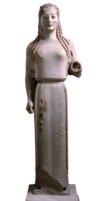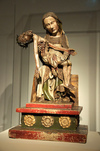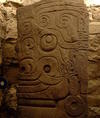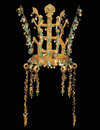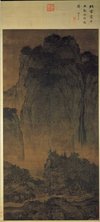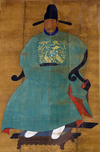Semester 1 Exam Flashcards
(96 cards)
1 Apollo 11 Stones
(25,500- 25,300 BC)-dated by later of dirt found in Namibia
Charcoal on stone
Windhoek, Namibia

2 Great Hall of the Bulls
(15,000-13,000 BC)
Paleolithic Europe
Rock Painting
Lascaux, France

3 Camelid Sacrum
(14,000-17,000 BC)
Central Mexico
Bone
lost (no place of residence)

4 Running Horned Woman
(6,000-4,000 BC)
Algeria
Pigment on Rock
Tassili n’Ajjer, Algeria

5 Bushel with Ibex Motifs
(4,200- 3,500 BC)
Susa CUlture (Iran)- in burial mound
painted terra cotta
Paris, France

6 Anthropomophic Stele
(4000-3000 BC)
Ha’il, Saudi Arabia
Sculpted Stone
National Museum in Riyadh, Saudi Arabia

7 Jade Cong
(3,300- 2,200 BC)
Liangzhu Culture in the Yangtze River Delta of China (also make bi= round jade disc)
Carved Jade (must be sanded)
British Museum, London
-use unknown; always reclangle with cirlcular hole and horzontal striations

8 Stonehenge
(2,500-1,600 BC)
Wiltshire, UK–Neolithic Europe
Sandstone (each boulder 25 ft high and 25 tons)
related works: Ménec France, Zorats Karer

9 Ambum Stone
(1500 BC)- dated usinf foilage inside when broken in transport
Ambum Valley, Enga Province, Papua New Guine
stone carving (used as mortar and pestle)
Australia National Gallery, Canberra

10 Tlatilco female figurine
(1200–600 BC)
Tlatilco, Mesoamerica (present-day Mexico)- found in burail site
ceramic with traces of pigment
Princeton University Art Museum
- typical female association: breasts and wide hips
- emphasis on duality (shared body and eye)

11 Terracotta fragment
(1000 BC)
Lapita people; Santa Cruz Islands Polenesia
red-slip earthenware
University of Auckland
-you can see a face carved in

12 White Temple and its Ziggurat
(3517-3358 BC)
Uruk, Iraq (Sumerian)
Mudbrick
Warka, Iraq

13 The Palate of King Narmer
(3,000-2,920 BC)
Pre-Dynastic Egypt (Hierakonpolis, Egypt)
Greyware (sandstone and clay)
Egyptian Museum, Cairo
-used to grind pigments

14 The Votive Figures
(2700 BC)
Sumerian from the Square Temple at Eshnunna (Tell Asmar, Iraq)
gypsum alabaster, shell, black limestone, and bitumen
The Metropolitan Museum of Art (NY, NY)

15 Seated Scribe
(2620-2500 BC)
4th Dynasty, Old Kingdom Egypt
painted limestone with rock crystal, magnesite, and copper/arsenic inlay for the eyes
Musée du Louvre, Paris

16 Standard of Ur
(2600-2400 BC)
Royal Cemetery at Ur, Mesopotamia
shell, red limestone, lapis lazuli, and bitumen
British Museum, London
- tells story of war and eveyday life on either side
- buried next to a warrior

17 Great Pyramids of Giza and the Great Sphinx
(2551-2528 BC)
Giza, Egypt
50ton stone blocks
Giza

18 King Menkaura and Queen
(2490–2472 BC)
Menkaure’s Pyramid Giza, Egypt
greywacke
Museum of Fine Arts, Boston

19 The Law Code Stele of Hammurabi
(1792-1750 BC)
Babylon, Mesopotamia (Iraq)
Stele Carved; cuneiform inscribed
Louvre, Paris
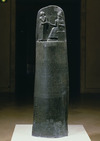
20 Temple of Amun-Re and Hypostyle Hall
(2055-1650 BC)
18th and 19th Dynasties, New Kingdom
sandstone and mud brick
Luxor, Egypt

21 Mortuary Temple of Hatshepsut
(1479-1458 BC)
New Kingdom, Egypt
stone maonry
Deir el-Bahri, Egypt

22 Akhenaton, Nefertiti, and three daughters
(1350 BC)
New Kingdom, Amarna period, Egypt
limestone
Berlin, Germany
-new depiction of royalty in more soft, relatable sense

23 Tutankhamun’s tomb
(1323 BC)
New Kingdom, 18th Dynasty, Egypt
gold with inlay of enamel and semiprecious stones (form of a god)
Egyptian Museum, Cairo

24 Last judgment of Hu-Nefer, (Book of the Dead)
(1275 BC)
9th Dynasty, New Kingdom, Egypt
ink on papyrus
British Museum, London



